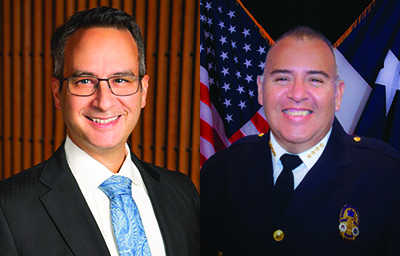
Mark E. Escott, MD, MPH, FACEP, FAEMS, NRP, is the EMS system medical director for the City of Austin and Travis County, Texas, and a clinical assistant professor of surgery and perioperative care at the University of Texas at Austin Dell Medical School. He is the immediate past chair of the Section of EMS and Prehospital Medicine of the American College of Emergency Physicians. Ernesto Rodriguez, MA, EMT-P, is the chief of Austin-Travis County EMS and a certified improvement advisor with the Institute for Healthcare Improvement. He also served on the EMS Agenda 2050 Technical Expert Panel.
EMS Week offers a chance to talk to your community about where EMS is today—and where it’s headed tomorrow
By Mark Escott, MD, MPH, FACEP, FAEMS, NRP, and Ernesto Rodriguez, MA, EMT-P
EMS Week presents a great opportunity to engage with members of our community, from hospital and healthcare leaders, to local elected officials, to members of the public. Whether in a formal way at an awards ceremony or by simply striking up a conversation with a passerby learning hands-only CPR, take advantage of these chances to connect and share your vision for the future of your organization.
One key aspect of communicating with community members is making sure they understand what EMS is—and what EMS should be in the future. This year’s EMS Week theme offers a conversation starter: your stakeholders and constituents might understand what it means to prepare for tomorrow, but do they know what that tomorrow will look like? Many still think of EMS as simply ambulances responding with lights and sirens. It’s important for the public to understand that EMS is not a ride to the hospital; it’s healthcare. Here are just a few lessons that we’ve learned to help you have that conversation.
1) TALK TO YOUR OWN ORGANIZATION FIRST
Your people are your greatest asset. That’s true when they are responding to calls and helping patients, and it’s true when you’re trying to conduct outreach and education in the community. When applying to participate in ET3 (the Center for Medicare and Medicaid Innovation’s Emergency Triage, Treatment, and Transport Model), we realized that many of the EMTs and paramedics in our own agency were unfamiliar with the program and some of the concepts behind it. The future of EMS is filled with potential, but only when the members of our own profession unite behind these exciting new ideas. Don’t assume everyone in EMS is aware of efforts to move our profession forward, and don’t underestimate their passion for helping make those ideas a reality once they learn about them. Today’s field clinicians are the ones who will be tomorrow’s leaders, and they are the ones who talk to members of the public every day. Equip them with the information they need to tell our story.
2) LISTEN BEFORE YOU SPEAK
When you do reach out to the broader community, make sure you ask them what they expect from an EMS system. Then engage them on what you can off er. You might be surprised that even without following national trends in EMS, they have come to the same conclusions you have—that EMS can do more for a community than simply drive fast and deliver people to hospital doors.
3) MAKE SURE EVERYONE UNDERSTANDS THIS ISN’T JUST YOUR CRAZY IDEA
It’s one thing for the EMS director or a fi re chief to say things need to change. It’s another for that leader to come armed with examples from around the country of how EMS is innovating toward a people-centered, community health-focused mod-el. More than once, we have quoted the vision of the original 1996 EMS Agenda for the Future, which calls for an EMS system that provides “community-based health management that is fully integrated with the overall health care system.” Then we’ll turn to EMS Agenda 2050 and the six guiding principles and its description of people-centered EMS. Finally, we find examples from other communities. When we show stakeholders there’s national momentum, it changes the conversation. Local leaders begin asking if we’re leading the way or falling be-hind—they want to make sure their community isn’t missing out on something innovative that’s helping people in other places.
4) APPEAL TO HEARTS AND MINDS
People love data—they want to know the extent of the problem we’re trying to fix, and how much of a difference we can make, whether it’s improving health outcomes, making our community safer or saving money for the healthcare system or our agency. At the same time, numbers don’t evoke empathy. We usually start a conversation with a story that will touch the heart—we talk about individuals we have worked with and how we have helped make a difference in their lives.
5) WORK WITH COMMUNITY PARTNERS
It’s a lot easier for residents or your city council to get behind something that already has support from other community leaders. If you speak in unison with other public safety, social services and healthcare leaders, it will go a long way. Competing voices create confusion and build mistrust. Instead, bring key leaders and partners on board early and take advantage of those collaborations to strength-en your message.
There’s no doubt that EMS is in a transition period, much like all of healthcare. People want close, convenient, unscheduled and people-centered care. With the EMS systems’ infrastructure, communications, mobility and clinicians, we can play a significant role in transforming healthcare. We have long been part of the team that people turn to for any problem, working with our partners to find solutions every day on the street. Now we are showing that we can play a larger role in fixing some of the systemic problems our communities face, from homelessness to chronic illness to an overburdened emergency health system. To succeed, we must effectively tell the story of EMS, past, present and, most important, future. EMS Week is a great time to take that conversation to the next level.
